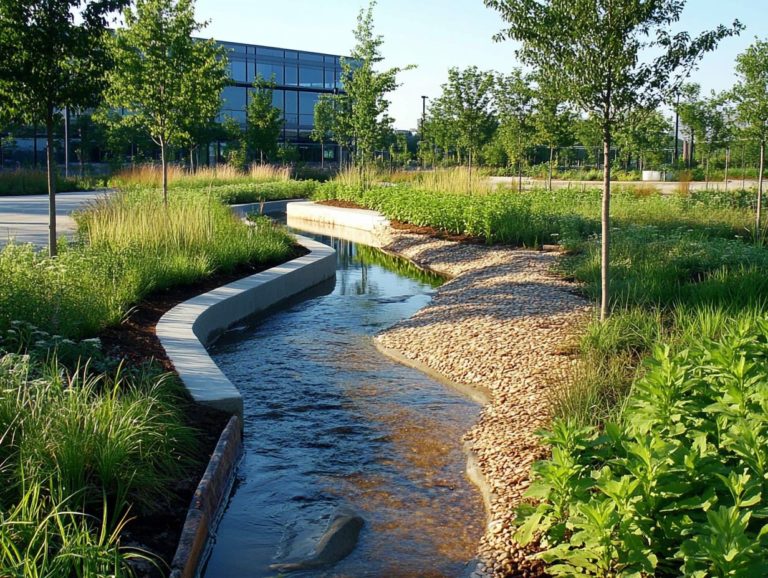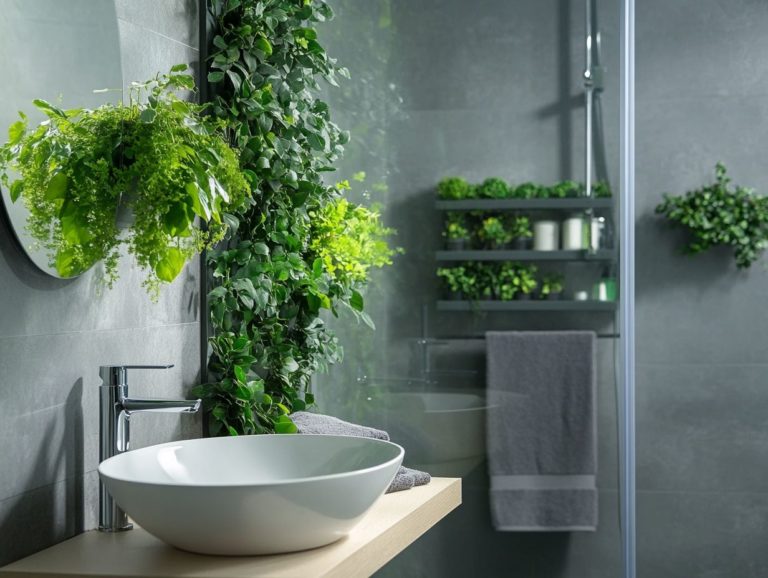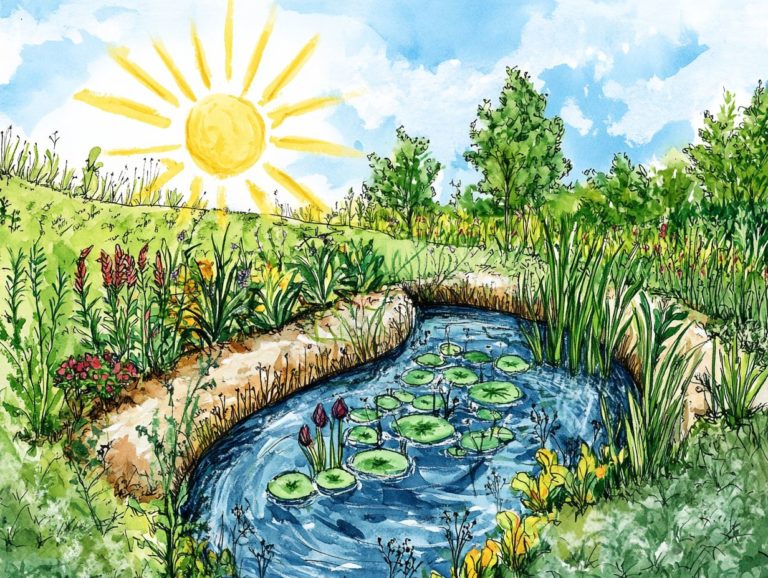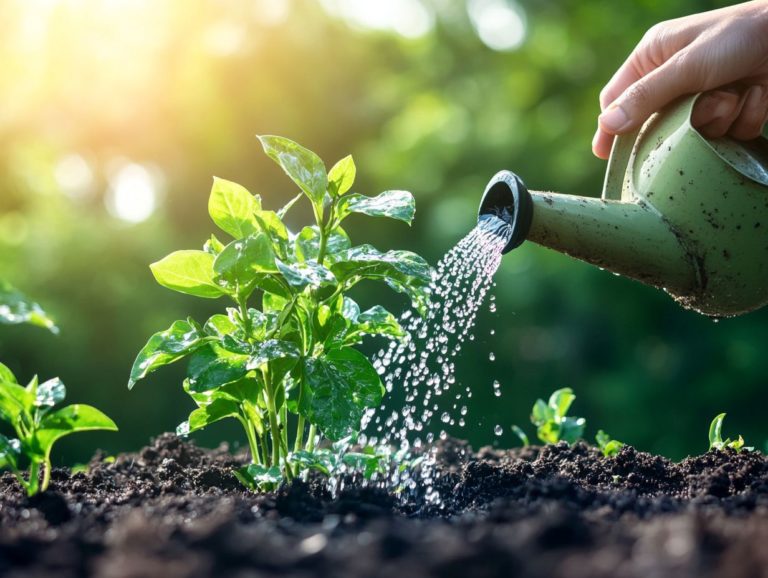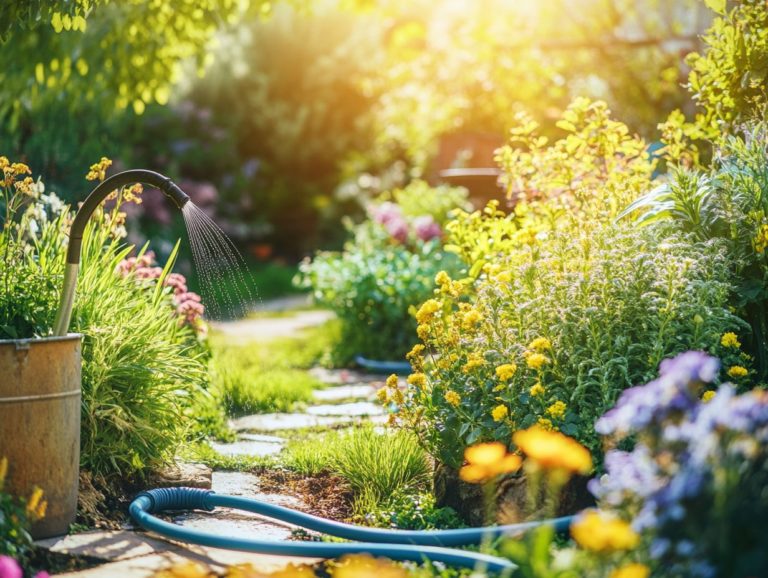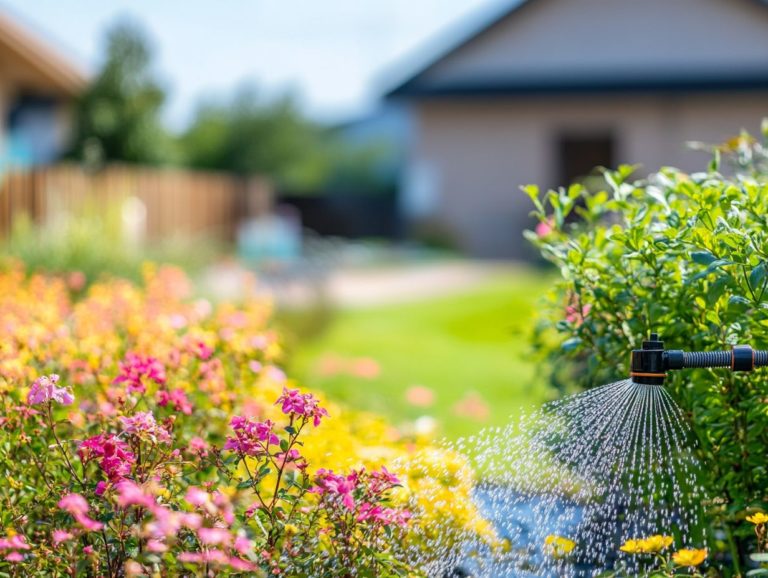5 Ways to Maximize Water Usage in Gardening
In a time when water conservation has never been more essential, gardeners are increasingly looking for innovative ways to nurture their plants while minimizing waste.
This article explores five effective strategies to optimize your water usage in gardening. By collecting rainwater, implementing drip irrigation systems, and selecting native or drought-resistant plants, you ll uncover practical tips that enhance your garden’s health and benefit the environment.
Immerse yourself in this exploration and discover how to cultivate a thriving garden with mindful water practices today!
Contents
- Key Takeaways:
- 1. Collect Rainwater for Irrigation
- 2. Use Drip Irrigation Systems
- 3. Choose Native and Drought-Resistant Plants
- 4. Mulch to Retain Moisture
- 5. Water Plants in the Morning
- How Much Water Do Plants Really Need?
- What Are the Benefits of Using Rainwater for Gardening?
- How Can Drip Irrigation Systems Help Conserve Water?
- What Are the Best Native and Drought-Resistant Plants for Your Area?
- Frequently Asked Questions
- 1. Can I reuse water from my home for gardening?
- 2. How often should I water my garden?
- 3. Is rainwater harvesting an effective way to maximize water usage in gardening?
- 4. How can I reduce water evaporation in my garden?
- 5. Are there certain plants that require less water?
- 6. Can I use a drip irrigation system to maximize water usage in gardening?
Key Takeaways:
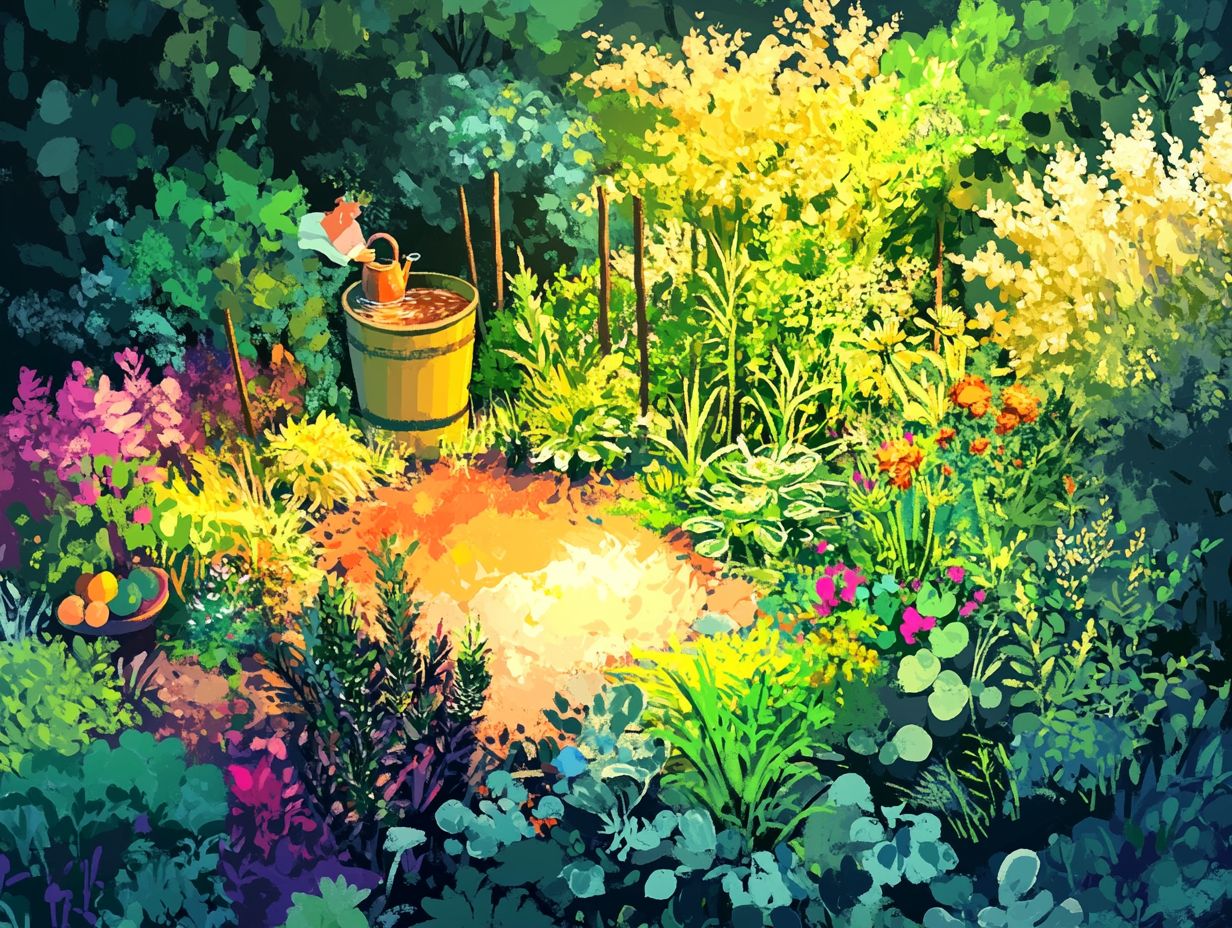
- Collect rainwater to use for irrigation and conserve clean water sources.
- Drip irrigation systems provide targeted and efficient watering for plants.
- Choose native and drought-resistant plants for lower water usage and less maintenance.
1. Collect Rainwater for Irrigation
Collecting rainwater for irrigation is an effective and sustainable practice that not only conserves water but also enriches your plants with natural, untreated moisture, free from the chemicals often found in tap water. This choice is ideal for homeowners aiming to enhance their backyard ecology while cutting down on water bills and reliance on municipal sources.
To start collecting rainwater, install barrels beneath your gutters to capture runoff from rooftops. This gives you a reliable water source during dry spells when your garden needs it most. Once gathered, this precious rainwater can be directed into irrigation systems, delivering moisture directly to your plants and promoting optimal hydration without oversaturating the soil.
This method nurtures your plants and boosts soil health by encouraging beneficial microbial activity and improving nutrient availability. You might also consider implementing rain gardens to maximize water retention, allowing excess runoff to be absorbed, reducing erosion, and fostering a vibrant habitat for local wildlife.
To take your system to the next level, consider incorporating native plants that thrive on collected water, contributing to a healthier and more resilient ecosystem.
2. Use Drip Irrigation Systems
Drip irrigation systems are one of the most efficient methods for delivering water directly to the roots of your plants, effectively minimizing water waste while promoting the healthy growth of drought-tolerant varieties in your garden.
These systems comprise a network of tubes, emitters, and connectors that provide a slow, steady supply of water where it’s needed most. By focusing on the root zones, drip irrigation not only conserves water but also enhances the absorption of nutrients in the soil. Crops such as tomatoes, peppers, and avocado trees flourish under this method, enjoying optimal moisture levels for their development.
Incorporating smart technology like timers and moisture meters significantly boosts the system’s efficiency. You can easily control your watering schedules based on the actual moisture needs of your soil. This thoughtful combination nurtures healthy soil, encourages robust plant growth, and ultimately leads to improved yields with reduced water consumption.
3. Choose Native and Drought-Resistant Plants
Choosing native and drought-resistant plants for your garden significantly reduces your water needs. These plants also support local ecosystems by providing important homes for wildlife and promoting sustainable gardening practices.
Understanding the unique characteristics of your local soil types and climate conditions is crucial in this endeavor. For example, if you’re in an arid region, succulents like agave and desert sage will thrive. They require minimal moisture and adapt seamlessly to sandy soils. In coastal areas, consider low-water plants such as seaside daisies and beach strawberry, which can handle saline conditions naturally.
Using these plants minimizes your water consumption while enhancing soil health. They increase organic matter and foster beneficial microorganisms. By integrating such plants, you encourage better water retention, ultimately leading to a more resilient garden capable of withstanding the challenges posed by a changing climate.
4. Mulch to Retain Moisture
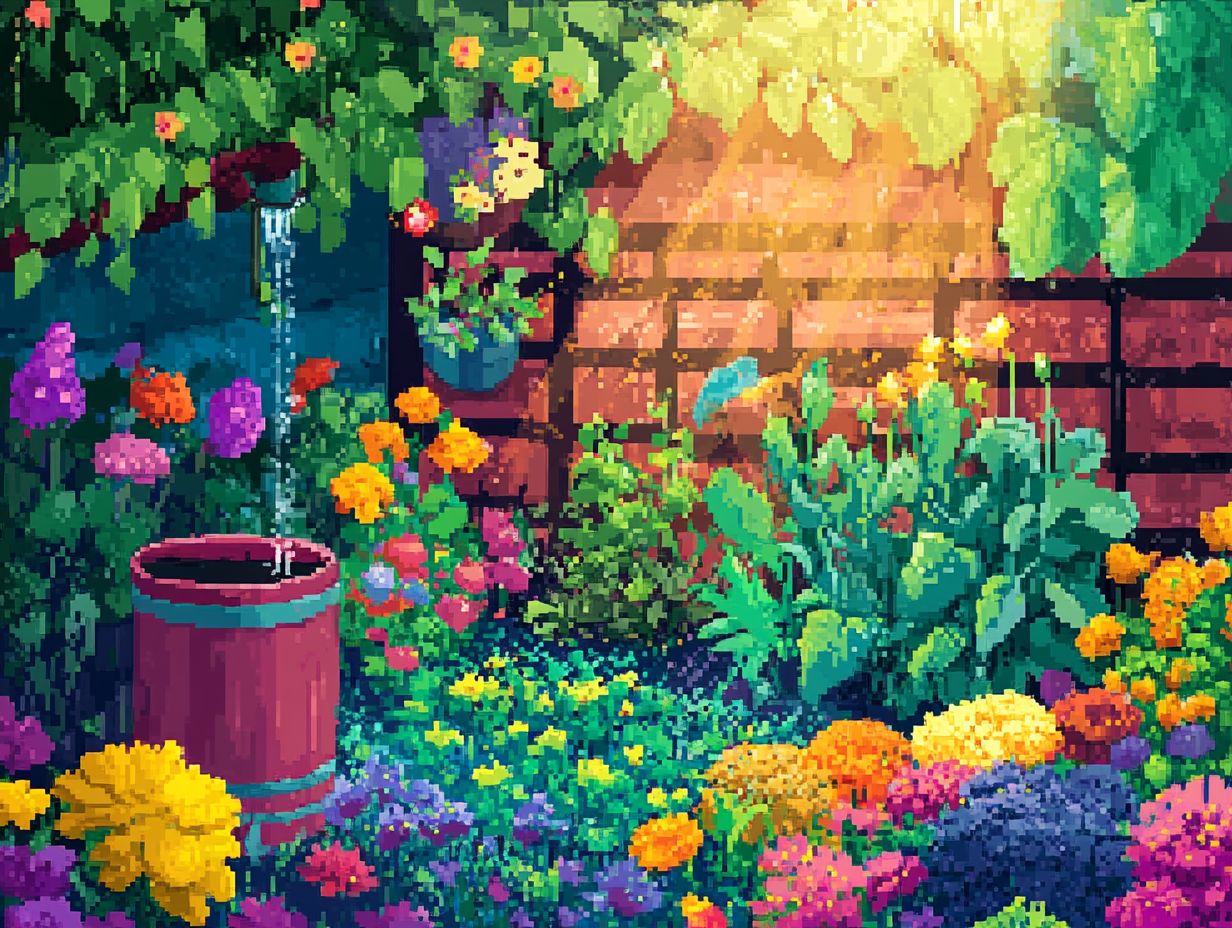
Applying mulch around your plants is a highly effective strategy for retaining moisture, regulating soil temperature, and suppressing weeds. These benefits collectively contribute to the overall health of your garden while reducing the need for excessive watering.
Different types of mulch present unique advantages tailored to specific gardening needs. For example, organic options like wood chips and straw elevate the aesthetic appeal of your garden and decompose over time, enriching the soil in the process.
To achieve the best results, aim for a mulch layer of 2 to 4 inches. Just be careful not to pile it against the stems of your plants, as that can lead to rot. Incorporating compost into the mix enhances soil nutrients, creating a healthier environment for your trees and other plants.
This strategy not only boosts growth but also creates a thriving garden!
5. Water Plants in the Morning
Watering your plants in the morning is a savvy practice that allows for deep hydration. This ensures moisture seeps into the soil before the day’s heat kicks in and starts evaporating it. This approach nourishes the roots and maintains an optimal moisture balance in the soil, essential for vibrant, healthy plants.
By hydrating in the early hours, you can take advantage of those cooler temperatures. This reduces the stress that high midday heat places on both your plants and the soil. For optimal results, consider the specific watering needs based on temperature shifts and the type of soil you have. Different soils need different watering schedules; sandy soils may need more frequent watering, while clay soils hold moisture longer.
To simplify your watering routine, think about using water timers. They can automate your schedule, ensuring consistency even on your busiest days, ultimately leading to enhanced plant health and growth.
How Much Water Do Plants Really Need?
Understanding the water needs of your plants is essential for nurturing a flourishing garden. Different species demand varying amounts of water depending on their type, growth stage, and environmental conditions. This highlights the importance of accurately assessing moisture levels and adjusting your irrigation strategies accordingly.
Several key factors influence these water requirements, including soil type and climate. For example, sandy soils drain quickly, often necessitating more frequent watering, while clay soils retain moisture for longer periods.
Local weather patterns also play a significant role in determining how often you need to water. During those hot, dry spells, your plants will undoubtedly crave more hydration. To make well-informed decisions about watering, consider using a moisture meter. A moisture meter is a tool that helps you check how wet the soil is.
By inserting the meter into the soil to measure moisture levels at various depths, you can fine-tune your watering practices to meet the specific needs of your plants. It’s also wise to water early in the morning or late in the evening to reduce evaporation, ensuring optimal hydration while effectively conserving water.
What Are the Benefits of Using Rainwater for Gardening?
Using rainwater for your gardening endeavors presents a wealth of advantages. You’ll enjoy lower water bills and watch your plants thrive, free from the harshness of chlorine and other chemicals. You ll also make a positive impact on the local ecology by embracing sustainable gardening practices.
Rainwater irrigation boosts plant growth and helps conserve our precious water resources. It significantly enhances soil quality, replenishing moisture levels and nurturing beneficial microorganisms that flourish in a nutrient-rich environment. This method not only fosters robust plant growth but also plays a crucial role in conserving municipal water systems, alleviating the pressure on local resources during dry spells.
Consider the examples around you: vibrant community gardens that effectively utilize rain barrels to nourish vegetables and flowers, or urban homeowners who create stunning rain gardens to enhance their landscapes while managing stormwater runoff sustainably. These instances beautifully illustrate the effectiveness of rainwater harvesting in action.
How Can Drip Irrigation Systems Help Conserve Water?
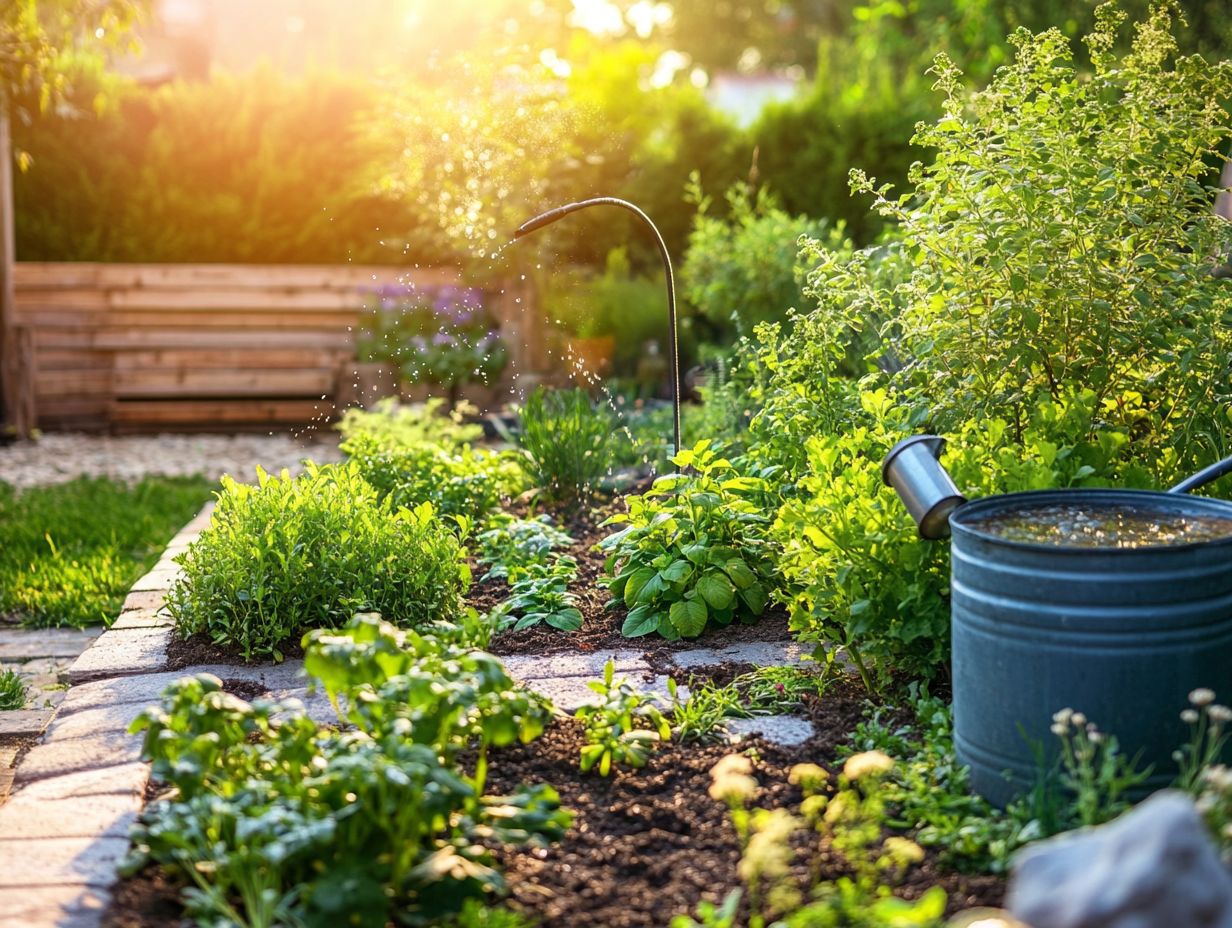
Drip irrigation systems are designed carefully to minimize water waste by delivering water directly to the roots of your plants, greatly enhancing conservation efforts in any gardening or agricultural environment.
By precisely addressing the watering needs of each individual plant, these systems ensure that every plant receives just the right amount of hydration, eliminating excess runoff. Unlike traditional watering methods that often leave you with uneven moisture levels and increased evaporation, drip irrigation offers a consistent moisture balance in the soil.
This level of precision fosters healthy plants and healthy soil while conserving water, making it a sustainable choice for both farmers and gardeners through effective water conservation.
By incorporating smart technology, such as moisture sensors, water timers, and automated timers, you can achieve even greater efficiency. These innovations allow for real-time adjustments in water delivery based on current data and environmental conditions, further optimizing usage and ensuring your plants thrive. For more tips, check out this guide on how to implement water-saving techniques in gardening.
What Are the Best Native and Drought-Resistant Plants for Your Area?
Selecting the finest native and drought-tolerant plants for your area can transform your garden into a sustainable haven that flourishes with minimal water. This approach supports local wildlife, reduces maintenance demands, and simplifies plant selection.
By choosing species suited to your local climate, you re enhancing your landscape and making a positive contribution to the ecosystem. For example, integrating native plants, flowering shrubs, and resilient perennials creates a nurturing environment for pollinators and beneficial insects, contributing to water-efficient gardening.
Exploring various gardening styles like xeriscaping, a gardening method that reduces the need for irrigation, or cottage gardens allows you to incorporate these hardy plants in visually captivating ways, ensuring they re both functional and aesthetically pleasing.
Incorporating xeriscape techniques sets the stage for a vibrant, eco-friendly garden that requires less water and actively supports biodiversity. Start your rainwater harvesting system today and watch your garden thrive!
What Types of Mulch Are Effective in Retaining Moisture?
Various types of mulch can effectively retain moisture in your soil, with natural choices like wood chips, straw, and compost offering added benefits such as improved soil nutrients over time. Making use of mulch trees can also contribute significantly to water retention.
Choosing the right mulch really hinges on your specific gardening needs along with the local soil type and climate conditions.
For instance, wood chips work wonders in perennial beds. They decompose slowly, creating a thick barrier that suppresses weeds while locking in moisture.
Straw, on the other hand, is perfect for vegetable gardens. It serves as a lightweight mulch that maintains soil moisture and supports water retention without compacting it too much.
Compost is another excellent choice. It not only aids moisture retention but also enriches the soil as it breaks down, making it suitable for a variety of plants and contributing to healthy soil.
When you apply these mulches, remember to create a layer about 2-4 inches thick. Leave a few inches of space around the bases of your plants to prevent rot and encourage healthy growth while using mulch everything as a strategy.
Why Is Watering Plants in the Morning More Effective?
Watering your plants in the morning is often the most effective strategy. It allows moisture to seep deep into the soil before the midday heat causes evaporation, ensuring your plants receive the hydration they need throughout the day and aligns perfectly with morning watering techniques.
This simple practice boosts the overall health of your plants and encourages robust root development. When the soil retains moisture longer, it can better meet your plants’ nutritional requirements, leading to lush foliage, vibrant blooms, and deep watering opportunities.
To establish a successful morning watering routine, consider using drip irrigation systems, drip hoses (hoses that allow water to drip slowly to the roots), or soaker hoses. These methods deliver targeted hydration directly to the roots. Aim to schedule your watering sessions early, ideally before 10 AM, to take advantage of cooler temperatures and minimize the risk of fungal diseases that can flourish in damp conditions later in the day. Incorporating a watering schedule can also enhance your watering practices.
Frequently Asked Questions
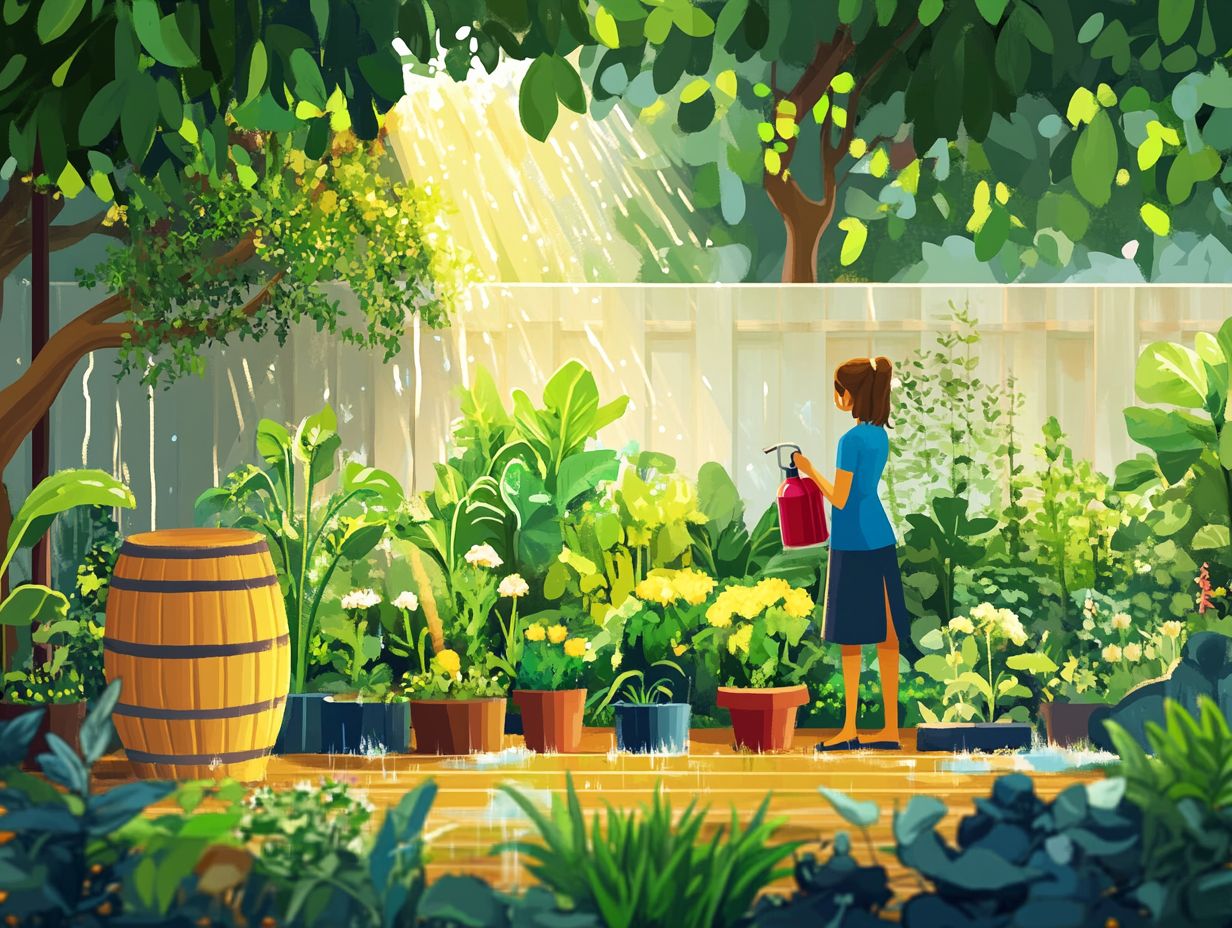
1. Can I reuse water from my home for gardening?
Yes, you can! You can maximize water usage by collecting and recycled water from your household activities, such as washing dishes or laundry. This not only conserves water but also reduces your water bill.
2. How often should I water my garden?
The frequency of watering your garden depends on various factors such as the type of plants, soil moisture levels, and weather conditions. Generally, it is recommended to water deeply and less frequently to encourage deep root growth.
3. Is rainwater harvesting an effective way to maximize water usage in gardening?
Yes, it is! Collecting rainwater in a barrel or container can provide a free and natural source of water for your garden. You can use this water during dry spells or to supplement your regular watering routine, enhancing your water-saving tips.
4. How can I reduce water evaporation in my garden?
One way to minimize water evaporation is by applying a layer of mulch around your plants. This will help retain moisture in the soil and reduce the need for frequent watering. Organic mulches, such as bark chips or compost, also provide nutrients for your plants and act as a weed suppressor.
5. Are there certain plants that require less water?
Yes, there are many drought-resistant and low-water plants that require less water to thrive. Some examples include succulents, cacti, lavender, and rosemary. Researching and incorporating these types of plants into your garden can help save water without sacrificing a beautiful landscape while enhancing water-efficient gardening.
6. Can I use a drip irrigation system to maximize water usage in gardening?
You can definitely use a drip irrigation system to maximize water usage in your garden. This efficient method employs a system of tubes to drip water directly onto the soil, delivering moisture right to the roots of your plants. Additionally, exploring 5 ways to use water wisely in permaculture can further enhance your water management strategies.
This approach minimizes water waste and supports the health of each plant by ensuring they receive just the right amount of water. Imagine giving your plants the perfect drink right at their roots!

